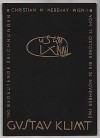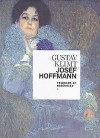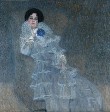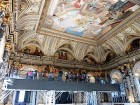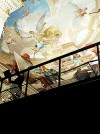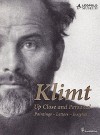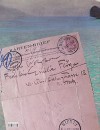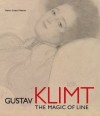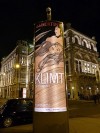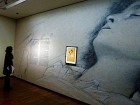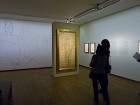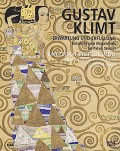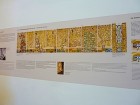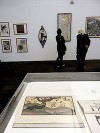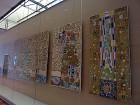The browser will either open the file, download it, or display a dialog.
Klimt Year in Vienna: Part One
Half a century ago, the centennial for Gustav Klimt (1862–1918) inspired three exhibitions in Vienna, each with a checklist or modest catalogue. The shows opened on consecutive days in mid-October 1962 and ran for five to eight weeks. Director Fritz Novotny of the Österreichische Galerie (now the Belvedere) displayed nineteen Klimt paintings from its holdings, as well as ten loans from private collectors. The Graphische Sammlung Albertina (now the Albertina) exhibited nearly 250 drawings selected by curator Alice Strobl from public and private collections, including 34 works owned by Rudolf Leopold (founder of the Leopold Museum in 2001). At Christian M. Nebehay’s gallery in the Annagasse (now an antiquarian bookstore still operating under his name), the art dealer and publisher mounted a show of another 150 “significant” Klimt drawings. Nebehay also lent seven works on paper to the Albertina exhibition and published the most substantial of the centennial catalogues (fig. 1).
By 1962 the city was beginning to attract from abroad, historians prepared to unveil Vienna in 1900 as the “laboratory of the future.”[1] The American scholar Carl E. Schorske published in Fin-de-Siècle Vienna (1980) an essay outlining for a broad international audience Klimt’s role at the cradle of modernism; Schorske used a detail from the artist’s vignette of a helmeted Pallas Athena on both front and back covers of his Pulitzer Prize–winning book.[2] A series of remarkable exhibitions in the 1980s—notably those initiated by Werner Hofmann (Hamburg, 1981), Peter Vergo (Edinburgh, 1983), the Biennale (Venice, 1984), Robert Waissenberger (Vienna, 1985), Jean Clair (Paris, 1986), and Kirk Varnedoe (New York, 1986)—disseminated the period’s rich visual evidence. Vienna 1900 became a brand, and Klimt, his gold burnished by cultural history, an easily identifiable logo.
Reflecting Klimt’s surging market share, for his 150th birthday eight museums and two artists’s societies organized eleven celebratory exhibitions in Vienna. At the opening of the Albertina show in March, Director Klaus-Albrecht Schröder praised the concept of this polyphonic tribute. No single retrospective, he suggested, could deliver a faceted understanding of this “most Austrian of Austrian artists” equal to the sum of the individual anniversary exhibitions, each one “part of a concert.” From mid-February until well into the autumn, a tourist in Vienna could visit three or four Klimt shows in any given month, as well as the permanent collection in the Belvedere; for residents, the marathon concert unfolded without intermission. The first five presentations in Vienna are described below, roughly in the order of their opening dates.
Gustav Klimt / Josef Hoffmann: Pioniere der Moderne / Pioneers of Modernism
Belvedere, Vienna
In cooperation with the Royal Museums of Art and History and the Royal Museums of Fine Arts of Belgium, Brussels
October 25, 2011 – March 4, 2012
Catalogue:
Gustav Klimt / Josef Hoffmann: Pioniere der Moderne / Pioneers of Modernism.
Edited by Agnes Husslein-Arco and Alfred Weidinger. Preface by Husslein-Arco and Michel Draguet; essays by Husslein-Arco, Marianne Hussl-Hörmann, Rainald Franz, Stefan Lehner, Eva Winkler, Weidinger, Ivo Hammer, Stephanie Auer and Alexander Klee, Maurice Culot and Anne-Marie Pirlot, Inga Rossi-Schrimpf, Nathalie Hoyos, Draguet, Matthias Boeckl, Ernst Ploil, and Markus Kristan.
Munich, London, New York: Prestel, 2011.
331 pp.; 390 color illustrations, 239 b/w; illustrated list of exhibited works.
ISBN: 978-3-7913-5149-0 (English trade edition)
ISBN: 978-3-7913-5148-3 (German trade edition)
€39,95 ($49.95; £35)
The Belvedere composed a dramatic overture to Klimt Year, introducing many themes pertinent to Klimt studies (fig. 2). Opening in October 2011 and running until early March, Gustav Klimt / Josef Hoffmann: Pioneers of Modernism then moved in an altered form to the Museo Correr in Venice. The exhibition focused on the collaboration of two Austrians, founders of the Vienna Secession in 1897, particularly on their joint exhibition projects and their efforts to achieve a Gesamtkunstwerk (figs. 3, 4).[3] Visitors often plunge somewhat abruptly into shows mounted at the Lower Belvedere; the narrow entry passage between the ticket desk and the exhibition entrance has little room for introductory material. For Klimt/Hoffmann, the narrative path offered an immediate choice: a dark corridor or the open space of a large gallery. Most viewers opted for the light, where they saw a free-standing model of Joseph Maria Olbrich’s Secession building (1897–98).[4] Sheared of its cupola and roof, the Secession model enabled viewers to examine the interior designed by Josef Hoffmann (1870–1956) for the Beethoven exhibition—the society’s fourteenth show—which ran from April 15 through June 15, 1902. Overhead, on three sides of the room, was what seemed to be the Beethoven Frieze, painted by Klimt for the Secession show and one of his three surviving monumental decorative projects in Austria (figs. 5, 6).
Museum-goers bewildered by the reconstruction returned to the sales area to rent an audio guide or hastened to the shop to consult the catalogue. The audio guide supplied a passage from Beethoven’s Ninth Symphony and explained its meaning for the Klimt frieze, but did not mention exactly what was on display. The catalogue identified the black-and-white reproductions in square niches below the frieze (62–63), as well as the Secession artists’ monograms under the images (71). Confusingly, the catalogue checklist gave the Belvedere inventory number for the original frieze (inv. 5987); many visitors knew, however, that the original had been on display in the basement of the Secession building since 1986. “Have they moved it?” gasped an art historian when she entered the initial room and looked up at the frieze. Only from Ivo Hammer’s painstaking catalogue essay on the work’s conservation history could a reader learn that more than a decade after its purchase by the Austrian State in 1973, the Bundesdenkmalamt (Federal Office of Monuments) completed a 1:1 copy (inv. 7165).[5] Financial support provided for the project from Venice permitted exhibition of the frieze copy in the 41st Biennale (May 20– September 16, 1984).[6] Producing the surrogate frieze was a conservation measure worth boasting about, yet the Belvedere appeared to dissemble its existence for the Klimt/Hoffmann exhibition. This reticence, as well as the absence of a photograph of the 1902 Secession gallery in or near the first room, hindered appreciation of the stunning reconstruction.
An equally astonishing feat was another re-creation in the corridor, visible through openings in the right wall under the frieze. Through these openings in 1902 one could see Max Klinger’s ten-foot Beethoven, now in the Museum of Fine Arts, Leipzig. In the Belvedere, the far wall of the darkened corridor served as a synecdoche of an earlier Hoffmann interior for the Secession room at the Exposition Universelle of 1900 in Paris. An array of paintings in Secessionist frames hung on ropes from replicas of the metal knobs used in Paris (276–7). As it had in 1900 at the exposition, the square portrait of Sonja Knips (1898), an important early patron of both Klimt and Hoffmann, found new admirers in the Lower Belvedere in 2012 (fig. 7).[7]
A third grandiose reconstruction of a Hoffmann space represented the great hall of the Palais Stoclet (1905–11), the inaccessible Gesamtkunstwerk of the Wiener Werkstätte in Brussels. Replica Hoffmann walls and pillars were clad with Paonazzo marble, and a George Minne youth in marble knelt by a portion of the stairway (figs. 8, 9). Nathalie Hoyos devotes a useful catalogue article to the Belgian couple Adolphe and Suzanne Stoclet and the origins of the Hoffmann commission to build their luxurious residence on the Avenue de Tervueren, inscribed since 2009 on UNESCO’s World Heritage List (194–201). Alfred Weidinger, curator of the Belvedere and Museo Correr exhibitions, also contributed an indispensable catalogue essay based on his recent findings in the Palais Stoclet archive (202–51). He concluded that Fritz Waerndorfer, managing director of the Wiener Werkstätte, was “the most essential motor behind the Stoclet project”; the Waerndorfer-Stoclet correspondence yielded a close account of the evolution of Klimt’s mosaic frieze for the Stoclet dining room.[8] Weidinger illustrates his essay with three of his own extraordinary photographs taken of the frieze in Brussels (231, 237, 239).[9]
Apart from the great hall reconstruction and a model of the Brussels mansion, the room included several relevant works by Fernand Khnopff, among them two drawings for decorations commissioned by the Stoclets. In his catalogue essay on Khnopff, Michel Draguet traces the Belgian artist’s connections to Vienna (252–73). After winning a gold medal in 1895 for Memories (1889; Royal Museums of Fine Arts of Belgium, Brussels) at a Künstlerhaus exhibition, Khnopff became a favorite of the Secession; he appeared in the group’s first show in 1898 with twenty works, among them the polychrome plaster Vivien (1896; Belvedere, Vienna). In the room devoted to the Palais Stoclet at the Lower Belvedere, Vivien and Khnopff’s painting Acrasia shared a wall with Klimt’s Nuda Veritas (fig. 10).[10] For comments from Klimt himself, visitors could read two picture postcards of the dining room and the great hall of the completed palace, written to his Lebensmensch Emilie Flöge during his visit to Brussels in May 1914. Mounted next to the reconstructed segment, the first card began: “The Palais Stoclet is really very, very beautiful. The postcards give no conception of it, or its appearance” (235, 240). Museum-goers in Vienna stepping into the replica could only agree.
Mini-reconstructions enhanced three major female portraits in the penultimate room of the show. An abbreviated structure suggested the fireplace over which the portrait of Marie Henneberg hung in the villa on the Hohe Warte commissioned from Hoffmann by the sitter’s husband, photographer and printmaker Hugo Henneberg [.pdf] (fig. 11). Hermine Gallia stood in a setting evoking the apartment designed by Hoffmann for the family; a sample of her boudoir furniture that survived her children’s escape to Australia had been shipped from the National Museum of Victoria to Vienna and Venice for the 2012 exhibitions (fig. 12).[11] Fritza Riedler, in her portrait inspired by Velásquez, has been found to share the canvas with a large Hoffmann cabinet made in 1903–04 for the anteroom of Klimt’s studio (fig. 13). Ernst Ploil, owner of the armoire, illustrates his catalogue essay with a double spread inviting comparison of the right edge of the cabinet with the gold and brown rectangle along the left edge of the painting (308–09).[12]
Two other newsworthy female portraits hung side by side in the room: the recently rediscovered Barbara Flöge, mother of the fashion designer, and Sunflower, interpreted in a wall text as a disguised portrait of her daughter Emilie (fig. 14). Painted around the same time as The Kiss, the sunflower rises alone above flowering mounds, prompting the Austrian critic Ludwig Hevesi to comment that it resembled “a fairy in love.”[13] In March, the Belvedere announced the acquisition of the picture as part of a bequest from the late collector Peter Parzer. Sunflower, lent to the centennial show in the Upper Belvedere fifty years ago, is scheduled to return there from Venice in July 2012 to take a prominent place among the world’s largest holdings of Klimt paintings.
The small final room contained the last of the clever tearsheets offered at other points in the exhibition to demonstrate the difference between the geometric and the curvilinear style (fig. 15). From these sheets visitors were encouraged to “make their own exhibition booklets,” and here the verso of Klimt and Hoffmann photographs offered a summary chronology of projects that united their shared interests. On the route back to the exit, some viewers bent to read a scuffed floor label, noticing for the first time that a lovely Klinger Beethoven sat hunched in the baroque Marble Hall. Facing an alarmed glass door, his back to the fountain figures by Rafael Donner and to crowds bearing electronic devices into or out of the Klimt/Hoffmann show, Beethoven seemed at first ill-placed (fig. 16). The Secession’s hero of 1902 frowned into the gardens toward the Upper Belvedere. Ignored by all but fans of either the composer or the sculptor, the marble from the Museum of Fine Arts, Boston, began to feel exactly right when one read on the worn label: “Gift of Paul Wittgenstein.” The pianist Paul, who had lost his right arm in World War I, had been the last surviving son of the Klimt and Hoffmann patron Karl Wittgenstein; a drawing for Paul’s sister Margaret’s portrait hung in the exhibition.[14] The return to Vienna of Beethoven’s legless torso and its connection with the mutilated heir of the Wittgenstein family indicates the reflection that lay behind this ambitious show and its richly-illustrated catalogue.[15]
Gustav Klimt nel segno di Hoffmann e della secessione
Museo Correr, Venice
Musei Civici di Venezia, in cooperation with the Belvedere, Vienna
March 24 – July 8, 2012
Catalogue:
Gustav Klimt nel segno di Hoffmann e della secessione
Edited by Agnes Husslein-Arco and Alfred Weidinger. Essays by Markus Feilinger, Husslein, Weidinger, Marianne Hussl-Hörmann, Rainald Franz, Stefan Lehner, Eva Winkler, Stephanie Auer and Alexander Klee.
Milan: 24 Ore Cultura, 2012.
239 pp.; 280 color illustrations, 170 b/w; illustrated list of exhibited works.
ISBN: 978-88-6648-097-6
€39 ($50; £32)
Both exhibition and catalogue received a new design in Venice, where the organizers celebrated Klimt’s sesquicentennial and his return to the Serenissima a little more than a century after his triumphant show at the ninth Biennale in 1910 (figs. 17, 18). The central works at the Museo Correr were Judith (1901; Belvedere, Vienna) and Salome, often called Judith II, first shown in Vienna at the Kunstschau of 1909 and purchased in Venice from the Biennale the following year for Ca’ Pesaro, Galleria Internazionale d’Arte Moderna.[16] The 1984 copy of the Beethoven Frieze also traveled from Vienna to Venice, where it was shown at eye level.[17] The Museo Correr could accommodate only a few drawings and decorations for the Palais Stoclet, not the reconstruction, but Venice received instead a new section on the young Klimt and the Künstler-Compagnie. For the Italian catalogue Markus Fellinger wrote a substantial essay on the artists’s cooperative formed by the three classmates at the Kunstgewerbeschule (Arts and Crafts School): Gustav and Ernst Klimt and Franz Matsch.[18] The thorough training of these young artists in all aspects of art production—along with active support and mentoring by their teachers—underlies their early success at obtaining a number of commissions for decorative works throughout the Austro-Hungarian Empire and, ultimately, on the Ringstraße in Vienna.
Gustav Klimt im Kunsthistorischen Museum
Kunsthistorisches Museum, Vienna
February 14 – May 6, 2012
Catalogue:
Gustav Klimt im Kunsthistorischen Museum.
Edited by Sabine Haag and Otmar Rychlik.
Vienna: Kunsthistorisches Museum, 2012.
72 pp.; 70 color illustrations; list of exhibited works.
ISBN: 978-3-99020-013-1
€14,90 ($19.40; £12)
Accompanying book:
Gustav Klimt, Franz Matsch und Ernst Klimt im Kunsthistorischen Museum.
Otmar Rychlik, with an essay by Ernst Czerny and English summaries by Otmar Binder.
Vienna: Edition Kunst/Agentur, 2012.
86 pp.; 62 color illustrations
ISBN: 978-3-9502145-6-7
€19 ($25; £16)
The last major contract for the Künstler-Compagnie was the subject of the Kunsthistorisches Museum’s contribution to Klimt Year (figs. 19, 20). The three young men had first worked at the museum around 1880, anonymously executing sgraffiti allegories of the arts and crafts for the two courtyards of the nearly completed building. They worked from designs by their teacher at the Kunstgewerbeschule Ferdinand Julius Laufberger, who died in 1881.[19] The director of the Österreichisches Museum für Kunst und Industrie and its school of arts and crafts, Rudolf von Eitelberger, probably recommended the young painters to Carl Hasenauer.[20] After Gottfried Semper left Vienna in 1876, Hasenauer was sole architect of the Burgtheater and the twin museums under construction on the Ringstraße. The commission to the Künstler-Compagnie to paint the two stairwell ceilings for the lateral entrances of the Burgtheater was dated October 20, 1886, and the emperor awarded all three artists medals of honor after the theater opened two years later.[21] When they received another commission on February 28, 1890, to paint stairwell decorations for the Kunsthistorisches Museum, the artists—although still relatively young—were already esteemed by the establishment and no longer boys, as Hasenauer called the trio: Franz Matsch was 29, Gustav Klimt, 27, and his brother Ernst, 26.
Their contract specified a ridiculous deadline, July 1890, and the spandrels and areas between the columns were awkward spaces to fill.[22] As in the Burgtheater, they divided the work equally among themselves. Franz Matsch took the south wall directly above Antonio Canova’s Theseus and the Centaur (1804–19).[23] Gustav Klimt completed the north wall, and Ernst Klimt, the east wall; for the west side of the stairwell, each painter worked on a bay. The twenty-four spandrels and sixteen intercolumnar canvases were affixed to the walls in April 1891.[24] The stairwell paintings were acclaimed when the new museum opened in October, although what viewers could see of the cycle—some forty feet above the ground floor—is unclear. A portfolio reproducing the paintings was published in 1893 by Albert Ilg, director of the decorative arts and weapons collection of the museum and designer of the program for the stairwell.[25] The Künstler-Compagnie had been asked to depict the main historical periods of art, beginning with ancient Egypt. In the 2012 Klimt exhibition, curator Otmar Rychlik displayed all sixteen plates from the Ilg portfolio, as well as six sketches for Klimt spandrels squared for transfer to canvas, along with more than seventy other items.[26]
The exhibition occupied one large room installed as a picture book, with attractive blow-ups of the Ilg plates above a running text in German; parenthetical numbers referred to the relevant objects on display. A better catalogue title would have been “Klimt and the Ringstraße,” for the wall text and exhibition began—like the printed catalogue—with the Burgtheater ceilings and drawings of the late 1880s and ended with the three ceiling paintings for the university completed around the turn of the century. In the show, appropriately, the museum stairwell dominated the presentation. The commission for the ensemble had gone in 1881 to Hans Makart: ceiling, twelve lunettes, and decorations in the spandrels and narrow spaces between the columns of the arcade on the lowest tier. Makart, the leading painter of the Ringstraße era, could complete only the lunettes and a sketch for the ceiling before he died in 1884.[27] His commission then went to Hans Canon, who was at work on the stairwell of the Naturhistorisches Museum; he produced a ceiling sketch for the art museum before he too died in 1885. The Hungarian painter Mihály von Munkácsy was offered the assignment on March 1, 1887. Munkácsy created a perfect Apotheosis of Renaissance Art with a flight of marble steps matching the real museum stairway. Under a fictive dome open to the sky is a loggia with a Medici coat-of-arms where Bramante shows a plan to a bearded pope; below the loggia Veronese stands on a scaffold, Titian instructs pupils on how to paint a nude, Leonardo chats with Raphael, and Michelangelo broods. Amazingly, Munkácsy painted his ceiling in a rented studio in Paris without seeing the museum space. He completed the huge canvas by May 1890 and, after exhibiting it in the Salon (Palais des Champs-Elysées) under the title Allegory of the Italian Renaissance, sent the rolled picture to Vienna. The Künstler-Compagnie was still painting the spandrels when the Munkácsy canvas was affixed to the ceiling in September 1890.
The exhibition catalogue features a useful centerfold photograph of the entire north wall by Gustav Klimt. The photograph also documents the Klimt bridge, a temporary scaffold spanning the staircase to permit a close look at the north side during the anniversary year (fig. 21). In his text Rychlik points out that, contrary to expectations, Klimt did not depict objects from the museum collections for his canvases; he turned instead to paintings at the Academy of Fine Arts.[28] Rychlik found that Klimt reversed Marco Palmezzano’s Portrait of a Young Man, given to the Academy in 1882 by Johann II Prince of Liechtenstein, in the left spandrel of Old Italian Art (fig. 22). In the right spandrel of the same bay, Rychlik discovered, Klimt had clothed his female saint with fabric derived from the draped throne in Coronation of the Virgin (1452) by Antonio da Fabriano; the source painting from the Academy was on view in the exhibition (fig. 23).
The catalogue cover is an attractive collage with details of an Ilg plate and a photograph of the Ancient Egypt spandrel. Of the museum spandrels, however, the text discusses at length only Pallas Athena, representing Ancient Greece (fig. 24). Athena figures would recur in Klimt’s work, especially around 1898 when he drew the poster for the first Vienna Secession exhibition. Franz von Stuck had made the goddess a symbol of the Munich Secession and its exhibitions; Carl Kundmann’s Pallas Athena Fountain (1893–1902) is Klimt’s spandrel transformed into public sculpture. For a discussion of Ancient Egypt and its adjoining panel between the columns, the exhibition catalogue refers the reader to a wonderful recent article by Ernst Czerny (23).[29] Czerny condensed his article for a second museum publication—what might be called an exhibition book (with English summaries)—including some of his meticulous identifications of the source for each Egyptian ornament or object (figs. 25, 26). Again, none came from the museum’s own collections; instead, Klimt put together his compositions from books and photographs, relying on Auguste Mariette’s album of photographs from the Cairo museum and other sources for inspiration.[30] For the lower body of the nude Egyptian goddess in his spandrel, Klimt may well have referred to drawings he or his brother had made at the Academy, inflating Lucas Cranach the Elder’s small Lucretia, turning her toward the viewer and giving her an ankh instead of a dagger.
Klimt executed several Italian subjects for the stairwell, treating the Florentine Cinquecento and Quattrocento in the first bay of the west wall (figs. 27, 28). In his David spandrel, the painter cleverly wrapped his hero’s arm around the column to dangle Goliath’s head into the dark space over a golden base inscribed in Latin “Whom God would destroy he first deprives of reason,” followed by his own initials “G. K.” and a branch of laurel. Rychlik’s book accompanying the exhibition is well worth the price for the Czerny summary and for the magnificent illustrations, particularly of David and Goliath on the west wall (29–32). In the Kunsthistorisches Museum this year many visitors—even those who had climbed the marble steps since childhood—encountered a new Gustav Klimt: the accomplished decorator of impossible spaces. He could adroitly imitate the gloss on a della Robbia cherub head or a black-figure vase, faithfully copy a papal tiara or hieroglyphs, even apply dabs of pastiglia and some prophetic gold. Recognizing the opportunity, museum-goers queued to climb up on the bridge, take their own photographs of the illuminated Klimts, and spread the word; the museum decided to keep the bridge until the end of the year (fig. 29).
Klimt persönlich: Bilder – Briefe – Einblicke
Leopold Museum, Vienna
February 24 – August 27, 2012
Catalogue:
Klimt persönlich: Bilder – Briefe – Einblicke / Klimt Up Close and Personal: Paintings – Letters – Insights.
Edited by Tobias Natter, Franz Smola, and Peter Weinhäupl. Essays by Natter, Wolfgang Georg Fischer, Hansjörg Krug, Sandra Tretter, Weinhäupl, Uwe Schögl, Ernst Ploil, Verena Traeger, Diethard Leopold, Stefan Kutzenberger, and Elisabeth Leopold; illustrated quotations section edited by Smola; letters from Klimt to Emilie Flöge edited by Tretter and Birgit Summerauer; biography section by Summerauer.
Vienna: Brandstätter, 2012.
431 pp.; 1,036 color illustrations; 63 b/w; chronology
ISBN: 978-3-85033-628-4 (German trade edition)
ISBN: 978-3-85033-629-1 (English trade edition)
€39,90 ($52; £32.50)
The public could also discover Ernst Klimt at the Kunsthistorisches Museum: his spandrel The German Renaissance on the east wall could be examined comfortably from the bridge. There G. K.’s younger brother had depicted his fiancée, Helene Flöge and her father, Hermann Flöge, a meerschaum pipe manufacturer. Ernst and Helene married in 1891, the year the Künstler-Compagnie delivered the canvases to the museum. For an adjacent bay Ernst had painted his own father, also named Ernst; father Klimt, a Viennese gold engraver costumed as a Dutchman, inspects the elaborate hilt of a sword. Both father and son would die the following year, the father in July, the young painter in December 1892; one of Ernst Klimt’s last works was an exhibition poster with the muses of comedy, lyric poetry, and tragedy. Gustav Klimt had gotten to know his sister-in-law Emilie Flöge, age seventeen when Helene married into the Klimt family; after his brother’s sudden death, Klimt was appointed guardian of his brother’s baby daughter, who was also Emilie’s niece. Emilie Flöge became a prominent fashion designer and the life companion of the painter. In her estate were nearly 400 postcards written to her by Gustav Klimt; these postcards formed the heart of Klimt: Up Close and Personal, a charming and intelligent exhibition at the Leopold Museum (figs. 30, 31).
Tobias Natter, director of the Leopold Museum since 2011, quotes in his introduction to the catalogue an article written shortly after Klimt’s death by the art historian Hans Tietze: “Even his friends,” Tietze wrote, “were hardly ever allowed to glimpse behind the wall that Klimt built around himself.”[31] Natter envisioned the show as a glance behind the wall, an attempt to allow Klimt to speak for himself through a correspondence more extensive than is commonly thought. In addition to the letters and cards to Flöge, Hansjörg Krug mentions in his catalogue essay (“Klimt and his Correspondence”) the famous nineteen-page letter of apology to Carl Moll dated May 19, 1899, explaining his relationship with Moll’s stepdaughter Alma Schindler (55–6).[32] Krug also discusses the sixty-five extant letters from Klimt to his mistress Marie (Mizzi) Zimmermann, all before 1903 (53–5).
The first glimpse of Klimt in the Leopold exhibition is not behind the wall, but out of doors (fig. 32). In a photographic enlargement the painter stands on a landing stage on the Attersee. Klimt’s first stay on the lake was documented by his signature in the guestbook at the Villa Paulick on August 10, 1900; the daughter of the villa owner was married to Emilie Flöge’s brother, Hermann. Visitors entering the show could take a seat on garden furniture from the villa to consult the catalogue; in their excellent essay on Klimt’s Sommerfrische, Sandra Tretter and Peter Weinhäupl describe the sites of Klimt’s vacations from 1900 to 1916, pointing out that “forty-seven of the fifty-eight landscape paintings attributed to Klimt were inspired by the Lake Attersee region” (62). Another enlarged photograph in the room suggested, by contrast, the artist’s public life in the city as the founding president of the Secession (fig. 33). Beyond the busy stalls of the old Naschmarkt stood Olbrich’s new temple of art; near the photograph hung a sketched proposal for the Secession façade. Klimt had drawn the sketch on the back of a letter to Alfred Roller dated May 4, 1897, about two weeks before the Secessionists officially withdrew from the Künstlerhaus. On the same wall was an uncensored version of Klimt’s poster for the first exhibition.
A wall of the second room displayed full-sized reproductions on canvas, based on black-and-white photographs, of the three Klimt ceiling paintings for the aula of the University of Vienna (fig. 34).[33] The commission awarded in 1894 specified that Matsch would execute the large central panel, Victory of Light over Darkness, and Theology, one of the rectangular fields devoted to the four faculties of the university (Fakultätsbilder). Klimt was to complete paintings of the other three faculties: Philosophy, Medicine, and Jurisprudence, as well as ten spandrels. The central panel by Matsch is the only part of the ceiling commission in place, although Theology survives in the offices of the Catholic theology faculty. After Klimt showed Philosophy at the seventh Secession exhibition in March 1900, eighty-seven professors signed a petition to the Education Minister protesting Klimt’s ceiling. Although the painting won a gold medal that summer at the Exposition Universelle in Paris, criticism continued in Vienna, accelerated with the exhibition of Medicine in 1901, and flared up again when all three paintings appeared in the Klimt retrospective in 1903. Weary of the scandal, Klimt withdrew from his contract, refusing to paint even the spandrels; they were finally executed by Matsch. On the Leopold Museum wall above the faculty painting replicas was a Klimt quotation dating from April 12, 1905: “I reject any form of State aid; I renounce everything” (183). He repaid his advance with the help of his patron August Lederer, who received Philosophy in return. Klimt’s colleague Kolo Moser bought Medicine and Jurisprudence in 1911. When Moser died in October 1918, Lederer arranged for his widow to sell Medicine to the Österreichische Galerie and acquired Jurisprudence himself.
In 1939, after the Anschluss, August Lederer’s large art collection, including his two faculty paintings, was seized from Lederer’s widow, Serena Lederer.[34] The Nazi Gauleiter Baldur von Schirach exhibited the three faculty paintings together for the last time from February 7 to March 7, 1943, in the Klimt show he organized at the renamed Secession; they were disingenuously labeled “from a private collection.” With other Klimts from the Lederer collection—their Beethoven Frieze, luckily, was stored elsewhere—the three paintings were removed from the Österreichische Galerie in April 1943 and sent “for safekeeping” to Schloss Immendorf in Lower Austria. Franz Smola, who contributed the praiseworthy 230-page middle section of the catalogue (“Quotes and Images”) tells the story of the faculty paintings succinctly and beautifully. Smola describes the occupation of the castle by a German SS demolition squad as the Russians approached in 1945, and the fire that broke out on May 10 after they left: “The fire was almost certainly caused by explosions resulting from delayed-action bombs set in the castle by the withdrawing SS unit. Over a dozen Klimt works were thus lost forever” (191).
Thanks to an initiative of the Leopold Museum, same-size reproductions based on photographs of the faculty paintings were made in 2005 in connection with the exhibition The Naked Truth; reproductions were then affixed to the aula ceiling in the hitherto empty fields, and the university placed a large explanatory display board in the foyer of the ceremonial hall. The faculty paintings—like the Portrait of Adele Bloch-Bauer, restituted to the late Maria Altmann in 2006 and now in the Neue Galerie, New York—haunt the 2012 anniversary, making intermittent spectral appearances as photographs in chronologies or in the final chapter of the Kunsthistorisches Museum show and catalogue (60–9).[35]
From the first room to the last, the postcards and pneumatic card letters to Emilie Flöge served as an artery angling through the exhibition. The display began with a single love letter decorated with a winged heart and referring to a “long kiss,” dated June 3, 1897; Klimt wrote it in haste at a Munich hotel desk. Handsome white vitrines at a comfortable height invited a close examination of this treasure trove of mail art (fig. 35).[36] Dietmar Eberle, architecture professor at ETH Zurich, designed the exhibition and its vitrines; he enabled a sparkling dialogue between quotations from the artist on the walls and selected paintings, allowing Klimt to comment on his own works. The postcards sometimes offered a dizzying peep into Klimt’s private life. On May 2, 1899, for instance, Klimt sent the first picture postcard of the collection to Flöge from Nervi—palm trees in the gardens of the Villa Gropallo—and wrote under the photo, “I am off to Verona then Venice–Vienna. Gustav.” Within the week he had allegedly inserted an exploratory hand under Alma Schindler’s collar as they gazed at the Ponte dei Sospiri in Venice. By Saturday, May 6, Klimt had been summarily banished from the city by Alma’s stepfather, Moll; the foiled seducer Gustav telegraphed Emilie to announce his return to Vienna the next day. In early June he wrote a pneumatic card letter to Flöge suggesting they cancel their joint French lessons for the summer, and another on July 6, 1899, saying he had tickets for the Raimund Theater for that evening and would expect her there. Elsewhere in the catalogue we learn from a forthright essay by Smola (“Gustav Klimt as a Father”) that Maria Ucicka bore him his first son, the future film director Gustav Ucicky, that very day, July 6, 1899 (205). Another son, also named Gustav, was born to Marie Zimmermann some two months later on September 1.[37]
Soon after his retrospective opened at the Secession in November 1903, Klimt departed for a fortnight in Italy. He sent Emilie a card of San Vitale on December 2: “Ravenna is very poor – the mosaics are of incredible splendor”; Klimt mailed a picture postcard nearly every day of the trip (fig. 36, 37). In the course of eight days in July 1908, he wrote eighteen colorful Wiener Werkstätte postcards to Emilie in Kammer-Schörfling on the Attersee and continued posting them from Munich, where he spent a few days before joining his friend for their first stay at the Villa Oleander. Exhibition visitors appeared captivated by the stream of postcards, drawn by their sheer abundance, their intimacy, and their sympathetic banality. In addition to the cards, the Leopold show included a wealth of objects: a bathing suit designed by Flöge, a sculpture from East Luba that Klimt might well have admired in the museum of the Congo in Tervuren, or a telescope stand from the Villa Paulick. A vitrine contained Franz Blei’s translation of Lucian’s The Dialogues of the Heterae (1907), designed by Hoffmann and illustrated by Klimt.[38] Next to the Lucian book, a closely hung wall displayed a number of Klimt’s erotic drawings amassed by Rudolf Leopold. Keeping pace with the postcards in nearly every room were photographs, among them a Lumière autochrome of 1913 by Friedrich G. Walker, the only color photograph of Klimt. Some of the most interesting portraits of the artist were taken by female photographers: Dora Kallmus (Madame d’Ora), Pauline Hamilton, and Emma Bacher, a daughter of the owner of the Villa Paulick. For the catalogue Uwe Schögl ably analyzes the photographs of Klimt in their social context, considering to what extent the artist influenced the image conveyed (84–97).
Looking up from the vitrines, visitors could read clearly in German and English some twenty Klimt quotations above a careful selection of paintings. Chosen to illustrate the artist’s stylistic transition in his own words, one wall quotation read: “Little squares were yesterday, naturalism is what counts, October 1909.” This proclamation arrived in Vienna on a joint card from Spain signed by Klimt and Moll, not to Emilie Flöge, but to Josef Hoffmann, whose nickname was “Quadratl [little square] Hoffmann.[39] Precisely what Klimt meant by naturalism remains unclear, but thanks to the airy hanging viewers could approach each work and note the use of perspective and other changes after 1909 (fig. 38). Klimt, however, continued to paint large square or nearly square canvases, returning to the spirit of his faculty painting Medicine in an intriguing allegory Death and Life (fig. 39).
Collector Ernst Ploil describes Klimt’s studios in a catalogue essay (98–107), and he lent furniture made by Hoffmann for a reconstruction of the anteroom of Klimt’s studio at Josefstädter Straße 21 (fig. 40). The studio interior is known through a single photograph by Moritz Nähr, presumed to have been taken shortly before the building was demolished.[40] The painting on the anteroom wall in the Nähr photograph is Hope II (1907–08; Museum of Modern Art, New York). At the Leopold Museum, viewers could step around the reconstruction to approach an enlarged photograph representing the view of a neighboring building that Klimt would have seen from the studio window; in the adjacent museum window a transparency drew visitors’s attention to the real building on the nearby Mariahilferstraße where Emilie Flöge and her sisters ran their fashion salon. On display in a subsequent room was a change-of-address notice documenting Klimt’s move in August 1911 to his last studio in the Feldmühlgasse in Hietzing, not far from Schönbrunn Palace (247).[41]
There he rented a small house with a garden, part of the terrain of one of the many villas in that wealthy neighborhood. As in the Josefstadt, the interior had an anteroom, shown in the exhibition as a photo enlargement with a real table in the viewer’s space (fig. 41). On a video screen inserted into the door of the familiar black cabinet, a three-minute colorized enhancement of Nähr’s photographs of 1918 ran continuously. Smola speculates that the black frames and tidy arrangement of Klimt’s ukiyo-e collection seen in the photograph were the work of Hoffmann (249). In a valuable essay Verena Traeger comments on Klimt’s collecting, mentioning items that have survived: a suit of samurai armor, two nineteenth-century Chinese paintings, five Japanese woodblock prints and, as seen in the Nähr image of the Hietzing workroom, two African stools (108–25). The photograph shows two unfinished paintings on easels – The Bride (Belvedere) and Lady with a Fan (private collection). A final section of the exhibition displayed tributes from younger colleagues, among them Oskar Kokoschka’s dedication to Klimt of Die träumende Knaben, a book commissioned by Fritz Waerndorfer in 1907 and exhibited in the Kunstschau of 1908. Also included was one of the drawings Egon Schiele made in the mortuary the day after Klimt’s death on February 6, 1918.
A delightful coda to the exhibition was a film directed by Peter Weinhäupl and co-written with Sandra Tretter, an excursion along the shore of Klimt’s beloved Attersee. With its critical mass of strong painted landscapes and vacation snapshots, Klimt Up Close and Personal was itself a Sommerfrische (fig. 42). An armature of unpretentious scholarship and architecture supported this beguiling show, and the catalogue serves as an agreeable souvenir.
Gustav Klimt: Die Zeichnungen / Gustav Klimt: The Drawings
Albertina, Vienna
March 14 – June 10, 2012
Gustav Klimt: The Magic of Line
The J. Paul Getty Museum, Los Angeles
July 3 – September 23, 2012
Catalogue:
Marian Bisanz-Prakken, with a foreword by Klaus-Albrecht Schröder and James Cuno
Munich: Hirmer, 2012; Los Angeles: J. Paul Getty Museum, 2012.
304 pp.; 243 color illustrations; 14 b/w; selected bibliography
ISBN: 978-3-7774-4951-7 (Hirmer English trade edition)
ISBN: 978-3-7774-4721-6 (Hirmer German trade edition)
ISBN: 978-1-60606-111-4 (Getty edition)
$49.95 (€50; £31.35)
The Leopold Museum invited us to peer into Klimt’s studios and to read a good deal of his mail. We watched him relaxing with friends and family during his summer holidays and caught a glimpse of him at his regular breakfast table in Schönbrunn on the terrace of the Meierei Tivoli. In Gustav Klimt: The Drawings, the Albertina offered the viewer another sort of intimacy (fig. 43). The display of 140 of the 170 sheets in the Albertina’s current holdings, supplemented by thirty drawings on loan, allowed us to see Klimt at work. After its run in Vienna, the exhibition opened in July 2012 at the J. Paul Getty Museum in Los Angeles with a second English catalogue and a new subtitle: The Magic of Line (fig. 44). Curator and sole author of the catalogue was Marian Bisanz-Prakken, the coryphée of Klimt drawings research. At the Albertina she began her work in 1975 as assistant to Alice Strobl (1919–2009), whose four-volume oeuvre catalogue of nearly 4,000 Klimt drawings appeared in 1980–89. In 1991 Bisanz-Prakken assumed responsibility for continuing research on the drawings, and some of her recent findings are incorporated in the current exhibition and catalogue.
Both catalogue covers use details from imposing autonomous female portraits in chalk, dating from 1897–98. Klimt showed the Albertina’s Lady with Cape and Hat in the first Secession exhibition and published it in Ver Sacrum in an issue for which he provided all the illustrations.[42] On the cover of The Magic of Line was the delicate Reclining Young Woman (cat. no. 23). It was one of two acquisitions by the J. Paul Getty Museum in 2009, their first works by the artist to enter the collection; the second drawing, also in the show, was Two Studies of a Seated Nude (1901; cat. no. 50), produced in connection with the painting Goldfish (1901–02; Kunstmuseum Solothurn, Dübi-Müller Stiftung). For the exhibition poster, still a significant advertising medium in Vienna, the Albertina enlarged a detail of Fish Blood, a full-page illustration in the March 1898 issue of Ver Sacrum (fig. 45). Bisanz-Prakken notes in the catalogue that the drawing, showing the influence of Aubrey Beardsley and Jan Toorop, marked “the beginning of a pictorial genre characterized by playful female eroticism and mysterious underwater scenes” (62).[43]
The first of four chronological sections in the Albertina show (and in its catalogue)—“Historicism and Early Symbolism: 1882–1892”—accustomed the visitor to seeing drawings hung on walls papered with colossal enlargements of other drawings (fig. 46). The small study for Antony and Cleopatra (cat. no. 2), a ceiling in the Stadttheater in Fiume painted by Klimt and the Künstler-Compagnie in 1884–85, will be included in the forthcoming Continuation and Supplement of Strobl I–IV. The drawing was more enhanced than dwarfed by the reproduction of one of the Albertina’s six black chalk studies on view in the first room, all for a Burgtheater ceiling entitled Shakespeare’s Theater (1886–88). For reviewers, the attractive and reproducible Reclining Girl (Juliet)and Two Studies of Hands (1886–87) was a favorite from the Albertina show’s press kit. Some critics and bloggers complained that the exhibition should have included small photographs when drawings were related to paintings, but the curator opted for line at its purest in the exhibition. In the catalogue entries, however, painted works were well illustrated. For Shakespeare’s Theater, for example, the entire ceiling painting appeared in color, along with details showing Klimt himself in the audience at the Globe; it is his only known self-portrait (29–30).
That an exhibition catalogue has proper entries is not to be taken for granted these days; Bisanz-Prakken builds them sensibly around single works, pairs, or a group of related catalogue numbers, according to subject and dating. In the first section, for example, she describes the watercolor Allegory of Sculpture (1889; MAK – Austrian Museum of Applied Arts / Contemporary Arts), along with the preliminary drawing acquired in 2008 by the Albertina (cat. no. 14; fig. 47). Klimt painted the watercolor for a luxurious silver-covered volume assembled by the Kunstgewerbeschule. The gift book was presented on June 24, 1889, to Archduke Rainer, Protektor of the Österreichisches Museum für Kunst und Industrie, on the twenty-fifth anniversary of the opening of the museum (46).[44] A tribute to the materials of sculpture—marble, bronze, and gold—the watercolor and the drawing also document Klimt’s thinking about allegorical uses of Athena Parthenos and Pallas Athena, sketched as helmeted and holding a lance in the lower margin of the Albertina drawing (46–51). The catalogue entry includes a photograph of the Roman sarcophagus relief of the Muses from the Kunsthistorisches Museum that Klimt used in his watercolor, as well as a photograph of the bronze Spinario.
The second section was “The Turn to Modernism and the Secession: 1895–1903.” Two works, both related to Toorop’s lithograph The Sower, are given individual catalogue entries: the Albertina’s pencil drawing Thalia and Melpomene (1898; cat. no. 24) and Girl with Long Hair in Profile (fig. 48). Both have similar vertical hatching; Bisanz-Prakken refers to “the graphic rain of the late 1890s” (70). She points out Klimt’s unusual use of ribbed paper and colored chalk in the second drawing and the “dark, mysteriously shimmering hair” of the woman in profile. Behind her is a frontal figure with a mass of red hair and glowing eyes reminiscent of Khnopff. In this section four chalk studies for the faculty painting Philosophy, twenty for Medicine (including the transfer sketch from ca. 1900), and two for Jurisprudence enabled the viewer to grasp Klimt’s focus on individual figures as he assembled his intricate ceiling compositions. Thirteen sheets of studies for the Beethoven Frieze reveal the influence of Toorop and George Minne; drawings of the naked forms of “The Three Gorgons” alternate between “the sensuously flowing and the strikingly angular” (116, fig. 49). The section includes studies for female portraits of the period, ending with four fascinating chalk drawings for Adele Bloch-Bauer I, three of them from the National Gallery of Canada and a fourth from the Kunsthalle Mannheim. Each shows the “powerfully accented, stylized triangle of her mouth—the magical center of attraction in all the studies of Bloch-Bauer” (150).
During the brief period of the third section—“The Golden Style: 1903–1908”—Klimt produced his best-known works. Bisanz-Prakken relates only one drawing in the show directly to The Kiss (1908; Belvedere), a sheet in the Albertina with two male heads in profil perdu (cat. no. 110). The earlier drawing of an Embracing Couple (1901; Albertina; cat. no. 63) for “This Kiss to the Entire World” was included with studies for the Beethoven Frieze. Those from 1907–08 (cat. nos. 103–108) for the mosaic “Fulfillment” were shown with other graphite studies for the Stoclet Frieze (1905–11; Palais Stoclet, Brussels). Even Standing Pair of Lovers, Seen from the Side (cat. 107), despite its abyss, merely “points” to the painting The Kiss (190–99). A transfer sketch for the painting The Three Ages of Woman (1905; Galleria nationale d’arte moderna, Rome), an early “Golden Style” work, was prominently displayed (cat. 93, fig. 50). Another key work in this section was notable for Klimt’s rare use of the brush on paper; Bisanz-Prakken (224) calls this frontal portrait, reminiscent of Toulouse-Lautrec, “the equivalent in drawing to the paintings of the Golden Style” (fig. 51).
Along with a dozen erotic nudes and studies for The Virgin (1913), several series of portrait studies hung in the final section: “The Late Years: 1910–18.” Particularly interesting are those for Adele Bloch-Bauer II (1912; private collection). Bisanz-Prakken mentions standing poses, inspired by Klimt’s admiration for the Empress Theodora mosaic in San Vitale, which date from the time of the earlier Bloch-Bauer seated portrait (264). She comments that the magical focus on the mouth has become “a neutral identifying feature” in two pencil drawings from 1911 for the second Bloch-Bauer image, painted in a style marked by Klimt’s visit to Paris in 1909 and his subsequent work on the Stoclet Frieze. Four drawings for another painting, a nearly frontal standing portrait of Paula Zuckerkandl (1912; presumed to have been destroyed in Berlin during World War II), show the head cut off at the top edge of the sheet; one of the four is published in the catalogue for the first time (cat. no. 148). Trepanned heads can be seen as well in the two Adele Bloch-Bauer studies in this section, as well as in three of the four earlier Bloch-Bauer images, seven of the nine Serena Lederer studies from 1898–99, all five Margaret Stonborough-Wittgenstein drawings in the show (1904), and also in a drawing for the third, unfinished posthumous portrait of Ria Munk (1917–18; cat. no. 166). Bisanz-Prakken, taking up the challenge of interpreting Klimt’s strategy, attempts to describe this insistent placement of the figure on the sheet, sometimes cutting off both head and feet, as in the pencil study for Ria Munk III [.pdf] (fig. 52).
Especially for those with the leisure to use the catalogue as a guide to the exhibition, the Albertina provided a vivid journey, allowing the visitor to observe Klimt the draftsman “finding himself again and again” through four broad phases of his life (11). Bisanz-Prakken calls drawing “a daily necessity” for Klimt, “since his constant and diverse approach to the line formed the core of his activity as an artist” (10). Experiencing Klimt’s line—sometimes precise, often flowing, finally vehement—is almost as satisfying in the catalogue as in the show. The author points out in the Nähr photograph of the Hietzing studio a hitherto unnoticed mobile drawing table on casters near the window; she imagines Klimt scooting his table nearer the model on the bed, perhaps pulling up one of the African stools to sit on (18). The catalogue, which ends with a double spread enlargement of that Nähr photograph, owes much to the large illustrations and sensitive design, as well as to the nuances teased out of each drawing by the author.[45] The Albertina’s contribution to the Klimt Year concert program was a virtuoso performance, limpid and finely calibrated.
Gustav Klimt, Erwartung und Erfüllung: Entwürfe zum Mosaikfries im Palais Stoclet / Gustav Klimt, Expectation and Fulfillment: Cartoons for the Mosaic Frieze at Stoclet House
MAK (Österreichisches Museum für angewandte Kunst / Gegenwartskunst; Austrian Museum of Applied Arts / Contemporary Art), Vienna
March 21 – July 15, 2012
Catalogue:
Edited by Christoph Thun-Hohenstein and Beate Murr. Foreword by Thun-Hohenstein; essays by Murr, Elisabeth Schuttermeier, Anette Freytag, Rainald Franz, and Johannes Wieninger
Ostfildern: Hatje Cantz, 2012.
129 pp.; 133 color illustrations; 27 b/w; bibliography of cited literature
ISBN: 978-3-7757-3305-2
€29,80 ($39; £24.50)
Only a few drawings for the Stoclet Frieze could be seen in the Albertina show, but the mosaic panels in Brussels can be appreciated in another form in Vienna. MAK (Austrian Museum of Applied Arts / Contemporary Arts) opened an exhibition in March 2012 to commemorate the Klimt birthday and to celebrate the completion of a six-year project to conserve the nine full-scale cartoons for the frieze in its holdings (fig. 53). MAK Director since September 2011, Christoph Thun-Hohenstein wrote an exceptionally thoughtful foreword for the catalogue. He comments on issues raised by Adolf Loos and others that the Wiener Werkstätte “departed from its target of utility and functionality and headed into an increasingly elite dead end of the most exquisite materials, most superlative manufacture and most refined taste”(8). Thun-Hohenstein suggests that Loos must have seen in Josef Hoffmann the Mephisto to the Faust he tolerated in Klimt. In another engaging catalogue essay, Rainald Franz traces the presentation and reception of the Klimt cartoons (89–95). Since the 1920s, the cartoons have been stored at MAK, at first on loan from the Primavesi family, who assumed financial responsibility for the Wiener Werkstätte after Waerndorfer's near-bankruptcy in 1914 (93).[46] In 1961 the museum purchased the cartoons from the Primavesi heirs (94).
The Stoclets commissioned Klimt in 1905 to produce a frieze for their dining room, without specifying the materials. Three preparatory designs preserved in MAK can be dated to 1907–08, and postcards to Emilie Flöge reveal that the artist began to work on the 1:1 cartoons in July 1910. Klimt used rolls of transparent tracing paper, and the cartoons’s unpainted edges, as well as their painted surfaces, bear Klimt’s handwritten instructions to the craftsmen who would execute the frieze in mosaic panels on marble (fig. 54). Working with wet gouache on the flimsy, hygroscopic paper was frustrating; he wrote in the lengthy annotation on one cartoon (for Part 3 of the frieze) that he could not provide exact measurements because “the paper keeps changing” (46). Beate Murr describes in her catalogue essay Klimt’s development of the frieze design in his cartoons and the discovery that he used platinum, more expensive than gold, instead of silver leaf metal, evidence that he thought of them as “fully valid paintings” (26). She discusses her approach to conserving and rehousing those thin and fragile works, Vienna’s principal relics of the Wiener Werkstätte interior in Brussels.
The one-room exhibition began with a few photographs of the Palais Stoclet near a pair of mysterious transparent banners (fig. 55). Probably few viewers understood that these banners represented the cartoon of “Expectation,” mirror inverted, and “Fulfillment” placed somewhat offset over it. This display was meant to communicate one of the central points of the exhibition: the east wall of the Stoclet dining room is a reversal of the west wall. Moreover, Klimt reversed and traced the cartoon for the figural panel in the west wall—the dancer now called “Expectation”—leaving out the dancer herself (24). In her place he introduced the “Lovers,” originally meant to depict Adolphe and Suzanne Stoclet and later called “Fulfillment” (fig. 56). This one new element for the east wall emerged from the earlier cartoon, and the traced spirals from “Expectation” still show through on the new drawing for “Fulfillment,” as in the woman’s face (fig. 57).
Exhibitions about conservation are notoriously arduous for lay audiences. MAK opted for a traditional white wall panel of text and photographs, including an array of all nine cartoons (fig. 58). Each long wall of the Stoclet dining room consists of seven marble panels visually connected by a flowering meadow as a ground strip with a low, slightly undulating horizon and by the central motif of a tree with spiraling branches (fig. 59). An astute catalogue essay by Johannes Wieninger—“Japonisme in Gustav Klimt”—detected in the Viennese painter’s work during the period from 1907 until the completion of the frieze in 1911 an influence from Japanese screen painting, particularly Ogata Korin and the Rimpa School (97–119). Wieninger convincingly relates the form of the continuous meadow at the base of the frieze to screens by Korin and Tawaraya Sotatsu (112). A small segment of the exhibition presented a few examples of relevant Japanese objects (fig. 60).
Whatever confusion arose in the exhibition about tracings and mirror images melted away one flight down, where a new temperature- and relative humidity-controlled vitrine displays the nine cartoons without framing or glazing (fig. 61). They hang in the order of the first seven for the west wall, separated clearly from “Fulfillment” (Part 8) and “Knight” (Part 9). The subject of “Knight,” the cartoon on thicker paper for the abstract relief at the narrow end of the Stoclet dining room, was not recognized as such until the publication in 1987 of Klimt’s postcard to Emilie Flöge written in Brussels on May 18, 1914. There Klimt wrote: “My poor Knight is quite black and green” (fig. 62).
For a description of the distant marble panels in Brussels, the catalogue offers a well-illustrated essay by Anette Freytag, “The Tree of Life Frieze by Gustav Klimt as Artificial Garden in the Dream House” (69–87). Elizabeth Schmuttermeier mined the Wiener Werkstätte archives on the Stoclet commission, producing a list of designers and objects (49–67). Surprisingly, she found no trace of any financial arrangements for the metal inlays, ceramic, enamel, glass, or mother-of-pearl flowers, birds, and butterflies that translated, through Klimt’s meticulous instructions, the flat cartoons into a remarkable relief. Johannes Wieninger closed the exhibition with a cabinet of souvenirs and the catalogue with a brief essay (“Bijoux Style”) on the Klimt cult and its meaning for Vienna. He points out the boom in images once Klimt’s copyright expired in 1988 (seventy years after his death in 1918) and includes a reminder that at the time the state purchased the Beethoven Frieze in 1973, it was intended for the foyer of UNO City; instead, on conservation grounds, a room was built to display it in the basement of the Secession (127). Wieninger aptly uses as an epigraph the lines written by the critic Hevesi in 1909: “Woe to us all if the mob of nimble-fingered and simultaneously obtuse imitators rush in to 'Klimticize’ everything. It might become a real epidemic.”[47]
The Belvedere in Pioneers of Modernism and the MAK in Expectation and Fulfillment—the first and the last of five exhibitions under review here—dealt with the Palais Stoclet, but from quite different perspectives. Both exhibitions and both catalogues contributed to an awareness of a masterpiece seldom seen and known in detail only by specialists. Occasional overlapping of the shows has raised a question much discussed in Vienna: would it have been better to have mounted one grand, curated retrospective, rather than let each museum map its own response to Klimt Year? The issue came up in mid-May when a panel of experts—a museum director, the director of the Vienna Tourist Board, a curator, a cultural advisor to the government, and a critic—met to discuss a broader question: “How much Klimt can Vienna stand?”
The interim conclusion was, “Plenty!” Each of the panelists and several members of the audience declared that he or she had learned a vast amount so far. Their response supports Albertina Director Schröder’s applause for the concert approach to the Klimt anniversary. When all the exhibitions will have opened and closed, attendance will be tallied and the number of overnight stays in the capital compared with those during Mozart Year in 2006. Bolstered by publicity, the Attersee region is opening a new Klimt Center on the artist’s birthday, July 14, and the organizers hope for good weather and a stream of summer visitors. Meanwhile, Vienna has already produced six new exhibition catalogues—most of them with English editions or summaries, but all of them lacking an index—to be wedged into the Klimt monograph sections of library shelves. The jury is still out, but looking back on the highlights of the first months of 2012—the Palais Stoclet reconstruction, the Klimt bridge, the postcards to Emilie Flöge, the intimate and energetic drawings, and the rehoused MAK cartoons, safely installed in their own vitrine—it seems doubtful that a retrospective would have offered anything better than the Vienna museums’s mosaic picture of Klimt’s life and ceaseless work.
Jane Van Nimmen
Independent scholar, Vienna, Austria
vannimmen[at]aon.at
The author is grateful for the generous assistance of the following press officers: Giulia Zanichelli, 24 Ore Cultura, Milan; Ilaria Bolognesi, Alef, Milan; Judith von Wallenberg-Pachaly, Kunsthistorisches Museum, Vienna; Klaus Pokorny and Anna Suette, Leopold Museum, Vienna. Rotraut Krall and Beatrix Kriller-Erdrich of the Kunsthistorisches Museum offered information on the stairwell paintings.
[1] Hubert Christian Ehalt used the phrase in a eulogy [.pdf] delivered on April 25, 2012, at a ceremony awarding Carl E. Schorske honorary citizenship of the City of Vienna. Schorske’s first article on the subject was “Politics and the Psyche in Fin-de-Siècle Vienna: Schnitzler and Hofmannsthal,” American Historical Review 68 (July 1961): 930–46, republished as the first chapter in Fin-de-Siècle Vienna: Politics and Culture (New York: Knopf, 1980). The writer Arthur Schnitzler was born in Vienna two months before Klimt in 1862, and his 150th birthday was commemorated with theatrical productions and readings at the Berliner Ensemble and in Vienna, where there was also a small photographic exhibition in a neighborhood museum; his name, however, clearly lacks the commercial draw and product placement potential of Klimt’s.
[2] Schorske, “Gustav Klimt: Painting and the Crisis of the Liberal Ego,” Fin-de-Siècle Vienna, 208–78. Klimt’s vignette Ars first appeared in the Secession journal Ver Sacrum 3, No. 1 (1900), cover and 5; he later used it on the poster and catalogue cover for his retrospective at the Secession’s 18th exhibition in 1903.
[3] The show also emphasized international impulses and relationships, particularly with Belgium, including catalogue sections on sculptor George Minne (Inga Rossi-Schrimpf) and the painter Fernand Khnopff (Agnes Husslein-Arco and Michel Draguet). The catalogue preface signed by Belvedere Director Husslein-Arco and Draguet, director general of the Royal Museums of Fine Arts, Brussels, described the Dutch artist Jan Toorop as a Belgian, an error carried over into the Italian translation. On Toorop’s influence, see the exhibition catalogue for the Gemeentemuseum, The Hague, by Marian Bisanz-Prakken and Hans Janssen, Toorop in Wenen: Inspiratie voor Klimt (Zwolle: Waanders, 2006).
[4] An excellent catalogue essay by Stefan Lehner (“The Beethoven Exhibition 1902: A Documentation,” 52-115; Italian edition, 90–143) includes among its illustrations color close-ups of the model made in 2011 by Gerhard Stocker.
[5] See Ivo Hammer, “Klimt’s Beethoven Frieze at 110,” 140-49; not included in Italian edition. Hammer was head restorer of the Beethoven Frieze after 1976. He identifies the painters of the 1984 copy as Thomas Huss, Heinz Leitner, Manuela Mitschke-Pokorny, and Christoff Serentschy (148, note 60).
[6] See also Ivo Hammer, “Il Fregio di Beethoven di Gustav Klimt,” Le arti a Vienna: Dalla Secessione alla caduta dell’Impero asburgico, exh. cat. (Milan: Mazzotta, 1984), 107–14. The 1984 copy, made with exhibitions in mind, has also been sent abroad to the Sezon Museum in Tokyo (1989), the Fundacion Juan Marchi in Madrid (2006–07), Tate Liverpool (2008), Hangaram Art Museum, Seoul (2009), the Stadthalle Balingen (2010), and the National Gallery of Victoria, Melbourne (2011); in all those shows, it was clearly identified as a copy.
[7] See the catalogue essay by Marianne Hussl-Hörmann, “Gustav Klimt and Josef Hoffmann: Crossroads,” 18–32.
[8] Alfred Weidinger “100 Years of Palais Stoclet: New Information on the Genesis of Gustav Klimt’s Construction and Interior Decoration,” 205.
[9] See Alfred Weidinger, Gustav Klimt (Munich: Prestel, 2007) for other color photographs of the Stoclet dining room.
[10] Draguet regrets the sale in 2006 of the Khnopff bust Future, or a Young Englishwoman (1898; Musée d’Orsay, Paris), once displayed in the Stoclet music room, now in the Musée d’Orsay (266). For recent bibliographical references to Khnopff, see Sura Levine’s fine review in this journal (Spring 2005).
[11] See Tim Bonyhady, Good Living Street: Portrait of a Patron Family, Vienna 1900 (New York: Pantheon, 2011) on the Gallia family and the children’s life in Australia after the Anschluss in 1938.
[12] Ploil lent the Hoffmann studio furniture in 2007 to the Neue Galerie, New York, for a reconstruction; see Renée Price, ed., Gustav Klimt: The Ronald S. Lauder and Serge Sabarsky Collections, exh. cat. (Munich and New York: Prestel, 2007). In the early days of the Belvedere exhibition, the black cabinet stood to the left of the portrait until it was removed to anchor the studio reconstruction in the exhibition at the Leopold Museum.
[13] Ludwig Hevesi, “Weiteres über Klimt,” Altkunst – Neukunst (Vienna: Carl Konegen, 1909), 319. Hevesi remarked: “New things happen in Nature as soon as a Klimt steps into it.”
[14] In a picture essay for the Vienna (14) and Venice (30–31) catalogues, Husslein-Arco demonstrates the influence of Khnopff on Klimt’s Margaret Stonborough-Wittgenstein.
[15] Klinger’s Beethoven torso was photographed in the Palais Wittgenstein music room (click on image 5 of 6 in the link); see Alexander Waugh, The House of Wittgenstein (London: Bloomsbury, 2008), third unnumbered page of photographs after p. 180.
[16] For the Italian catalogue Alfred Weidinger added an essay on the two paintings, relating Salome to the work of the mosaic artist Leopold Forstner and to Klimt’s preparations for the dancer figure in the Stoclet frieze (41–3).
[17] Also shown at eye level in an exhibition in Milan was a new partial copy of the last three sections of the frieze made by Maria Porro and a team of scenographic artists. Gustav Klimt: Disegni intorno al fregio di Beethoven ran from February 4–May 6, 2012, at the Spazio Oberdan, with a catalogue edited by Annette Vogel. It included an essay by Vogel, an updated and translated essay on the frieze by Marian Bisanz-Prakken (previously used in exhibition catalogues for the Kunsthaus Zurich in 1992 and the Stadthalle Balingen in 2010), and new essays by Lorenza Tonani on the Secession exhibition posters and Ver Sacrum.
[18] Alfred Weidinger had earlier produced an excellent Belvedere exhibition and catalogue on the subject: Gustav Klimt and the Künstler-Compagnie, exh. cat. (Weitra: Verlag Publication PN°1 - Bibliothek der Provinz, 2007).
[19]Laufberger’s most prominent monument is not without relevance for his most prominent student; the Minerva Fountain combines several of Klimt’s interests, among them mosaics, gold, and the goddess herself (depicted by Klimt in her Greek form as Athena). Created for the 1873 World’s Fair in Vienna, the fountain was later purchased for installation on the Stubenring between the Österreichisches Museum für Kunst und Industrie (now MAK, Museum of Applied Arts) and the Kunstgewerbeschule (now Universität für Angewandte Kunst). The purchase was arranged by Rudolf von Eitelberger von Edelberg, the first professor of art history at the University of Vienna and founding director of the museum, and Heinrich Ferstel, its architect (1871), as well as architect of the adjacent new building for the Kunstgewerbeschule (1877).
[20] See Michaela Seiser, “Die Künstler-Compagnie,” Gustav Klimt and the Künstler-Compagnie (2007), 56.
[21] See Christoph Brenner, “Der Burgtheaterzyklus,” in Otmar Rychlik, Gustav Klimt, Franz Matsch und Ernst Klimt im Burgtheater (Vienna: Edition Kunst/Agentur, 2007), 47.
[22] With elaborate pairs of allegories of the art cities of Europe on the exterior and the delicious youthful craftsmen of the interior cupola hall, both by the sculptor Rudolf Weyr, the museum can be regarded as the spandrel paradise of the expiring nineteenth century.
[23] Canova’s marble sculpture had survived the hazardous sea, land, and river journey from Rome via Belgrade to Vienna intact, but Theseus’s right arm [.pdf] was broken in 1890 on the way from the Volksgarten across the Ringstraße to the staircase landing of the imperial museum.
[24] For descriptions of all the spandrels, see Beatrix Kriller, “Die Zwickel- und Interkolumnienbilder” in Georg Kugler and Beatrix Kriller, Das Kunsthistorische Museum: Die Architektur und Ausstattung: Idee und Wirklichkeit des Gesamtkunstwerkes (Vienna: Brandstätter, 1991), 221–39.
[25] Albert Ilg, Zwickelbilder im Stiegenhause des k.k. Kunsthistorischen Hof-Museums zu Wien, von Ernst und Gustav Klimt und Franz Matsch (Vienna: Schroll, 1893). The museum would do well to make the plates from their library copy available on the Internet, as well as Ilg’s explanatory text.
[26] Of particular interest were photographs of Georg Klimt, a metal craftsman, who later fabricated the Secession building’s doors. He posed in costume for two of his brother Ernst’s spandrels; Georg had posed as Romeo for Gustav Klimt’s Shakespeare’s Theater ceiling for the Burgtheater; see Rychlik 2007, 81–3.
[27] Makart produced ten lunettes with a gold background: eight depicted great painters with their models, two featured painters in a central framed self-portrait supported by ignudi-like figures (Velásquez on the east wall and Rembrandt on the west side). For the north and south walls he painted female allegories on a blue background.
[28] Klimt’s former teacher Julius Victor Berger, by contrast, commissioned in May 1890 to paint a ceiling on Habsburg patronage for Room XIX, spiced it with recognizable objects from what is now the museum’s Kunstkammer, including Benvenuto Cellini’s Saliera.
[29] Ernst Czerny, “Gustav Klimt und die Ägyptische Kunst: Stiegenhausbilder im
Kunsthistorischen Museum in Wien und ihre Vorlagen,” Österreichische Zeitschrift für
Kunst- und Denkmalpflege 63, nos. 3/4 (2009): 259–77.
[30] Czerny found that Klimt’s chief sources were Auguste Mariette, Album du Musée de Boulaq (Cairo: Mourès, 1872) and Emile Prisse d’Avennes, Atlas de l’histoire de l’art égyptien (Paris: Bertrand, 1877). The vulture with outspread wings behind the nude spandrel figure resembles those on ceilings in the museum’s Egyptian collection, based on a chromolithograph of a grave ceiling from Sakkara in Richard Lepsius, Denkmäler aus Aegypten und Aethiopien (Berlin: Nikolaische Buchhandlung, 1849), Section I, pl. 41. Czerny (76), however, believes Klimt used Prisse d’Avennes, Pls. I.35 and II.91,6.
[31] [Hans Tietze], “Gustav Klimt’s Persönlichkeit: Nach Mitteilungen seiner Freunde,” Die bildenden Künste. Wiener Monatshefte 2 (1919), 1. The article included several Moritz Nähr photographs seen in the 2012 exhibitions. Tobias Natter’s most recent publication on Klimt is Gustav Klimt: The Complete Paintings (Cologne: Taschen, 2012).
[32] Henri-Louis de la Grange and Günther Weiß, 'Ein Glück ohne Ruh’: Die Briefe Gustav Mahlers an Alma (Munich: 1997), 437. Krug (55) notes that the letter to Moll, auctioned in 1981 in Marburg, is now in the Bibliothèque Musicale Gustav Mahler, Paris.
[33] A vitrine displayed the only color reproduction of a detail from Medicine from the portfolio by Max Eisler, Gustav Klimt – Eine Nachlese (Vienna: Österreichische Staatsdruckerei, 1931).
[34] See Sophie Lillie, Was einmal war: Handbuch der enteigneten Kunstsammlungen Wiens (Vienna: Czernin, 2003), 656–71.
[35] Kirk Varnedoe’s eloquent skepticism on the importance of the faculty paintings and the Beethoven Frieze (Vienna 1900: Art, Architecture & Design, exh. cat. [New York: Museum of Modern Art, 1986], 151–5) was set in context by Colin B. Bailey, “Prolegomena: A Klimt for the Twenty-first Century,” Gustav Klimt: Modernism in the Making, exh. cat.(New York: H. N. Abrams in association with National Gallery of Canada, Ottawa, 2001), 13–14.
[36] Wolfgang Georg Fischer discovered the correspondence in 1983 in the estate of Ernst Klimt’s daughter Helene, the niece of both Gustav Klimt and Emilie Flöge; the Leopold Museum catalogue includes a lively essay by Fischer on his find (16-49). Auctioned in London on October 6, 1999, the Flöge correspondence is now divided between the Leopold II Collection (private collection) and the Austrian National Library; see the beautifully illustrated Gustav Klimt and Emilie Flöge: Artist and Muse (London: Sotheby’s, 1999), Sale LO9572, Lot 66. On a terminal in the foyer of the Leopold show, visitors could search the postcards by the place from which they were mailed, with the full text in German and an English translation.
[37] The painter had spent the last three weeks of August 1899 with the Flöge family in Golling, near Salzburg. Smola sets the record straight on Klimt’s illegitimate children: there were six, not fourteen, by three different models, and two of his progeny died very young (205).
[38] For the catalogue Stefan Kutzenberger contributed a trenchant essay on the Heterae book project (144-63).
[39] Klimt had just spent a few days in Paris and mentioned to Emilie (postcard of October 19, 1909) that Hugo von Tschudi, director of the Bayerische Staatsgemäldesammlung, had taken him to a private gallery; Smola wonders if Tschudi communicated to Klimt his enthusiasm for Matisse (236). During that October trip to Paris, Tschudi commissioned Still Life with Geraniums (1910; Pinakothek der Moderne, Munich) from Matisse, the first painting by the French artist to enter a museum.
[40] The building at Josefstädter Straße 21 was replaced in 1911–12 by a handsome mixed-use apartment house, assumed to be the anonymous work of the Jewish architect Ernst Epstein, who committed suicide shortly after the Anschluss in 1938. The Austrian president Heinz Fischer lives in an apartment in the building.
[41] Klimt did not live in either studio, but remained with his mother—she died in 1915—and two unmarried sisters in an apartment on the Westbahnstraße 36. For psychotherapist Diethard Leopold, this arrangement “can represent a red flag of sorts,” suggesting “psychic gaps” (135). In his essay (“The Despondent Eroticist”) Leopold sifted the evidence of the postcards for Klimt’s mood swings and neediness. He also analyses the revision in 1915 of Death and Life, with a convenient reproduction of the color plate published in Die Kunst für Alle 28, no. 21 (1913).
[42]Ver Sacrum 1, no. 3 (March 1898), 18.
[43] Kirk Varnedoe wrote of the first two faculty paintings that Klimt had added to the vision of Auguste Rodin “a distinctive mood of subacqueous torpor”; see Vienna 1900, 153, as in note 35 above.
[44] The museum had opened in the Ballhaus of the Hofburg on May 12, 1864. Forty artists, young and old, contributed to the elaborate decorations of the gift volume; see Wilhelm Mrazek, “Die 'Allegorie der Sculpture’ vom Jahre 1889: Ein neuentdecktes Frühwerk von Gustav Klimt,” Mitteilungen der Österreichischen Galerie 22/23 (1978–79): 37–47. Mrazek suggested that the assignment of the three important allegories to the Künstler-Compagnie was evidence of esteem for their work. Ernst Klimt produced the Allegory of Painting, and Matsch, the Allegory of Architecture, both illustrated in the Albertina catalogue (48).
[45] Bisanz-Prakken lists a dozen of her pertinent writings in the selected bibliography, all of them worth consulting; see, for example, her essay “Gustav Klimt, the Late Work: New Light on The Virgin and The Bride,” in Gustav Klimt: the Ronald S. Lauder and Serge Sabarsky Collections (as in note 12), 104–29.
[46] Otto Primavesi and his cousin Robert both died in 1926; the cartoons are thought by Franz to have arrived at MAK soon after that date (93). His account differs somewhat from that of Alfred Weidinger in “100 Years of Palais Stoclet,” in the Pioneers of Modernism catalogue (234, note 83).
[47] Ludwig Hevesi, “Gustav Klimt und die Malmosaik,” Altkunst – Neukunst (as in note 13), 213.


